Sony E PZ 18-110mm f/4 G OSS Review

Introduction
The Sony E PZ 18-110mm f/4 G OSS is primarily designed for videographers, typically those that like to work with a single lens setup. It covers a range of 18-110mm, and you can use it with either Sony’s full-frame A7 and A9 range of cameras, or with APS-C sensor cameras, such as the A6500. Because of the crop factor, if you use it with such a camera, you get an effective focal length of 27-165mm. The second of Sony’s cameras to use an SMO (Smooth Motion Optics) design, using this lens when recording video helps to prevent problems such as focus breathing, focus shifts and axial image shifts when zooming. The lens has a design of 18 elements in 15 groups. Six of the elements are aspheric, and three are ED (Extra Low Dispersion). Along with this design, there’s also other aspects of the lens which are likely to be appealing to videographers, including a Power Zoom, an aperture ring which can have its clicks turned off, and a manual focusing ring. It is also dust and moisture resistant, making it a good lens to use in a variety of different shooting conditions, especially outdoors. You can use the Sony E PZ 18-110mm f/4 G OSS to shoot stills with, if you like, but there are arguably better suited lenses for stills photography which cover this focal length range. The Sony E PZ 18-110mm f/4 G OSS costs £3500 / $3500.
Ease of Use
The Sony E PZ 18-110mm f/4 G OSS lens is one of the largest lenses you can use with Sony’s E-mount system. That said, it’s not too heavy, making it good for handheld video shooting.
We have been using it with the Sony A6500, which has an APS-C sized sensor. Despite the camera’s relatively small size, the 18-110mm lens doesn’t feel too ridiculously unbalanced while attached to it. There is a very large lens hood provided in the box, which can double up as a lens cap, with a switch on the side to close the barn door style shutters. This is most likely to be used by video shooters - a standard lens cap is also provided.
The Sony E PZ 18-110mm f/4 G OSS lens itself has a reasonably complex design, but one which gives you quick access to a number of different features. At the front of the lens is a focusing ring, which can be pulled back to give you manual focus control only (as opposed to AF/MF). This is a super quick way to switch between autofocus and manual focus, and could be particularly useful for fine tuning focus when working in video. The ring is rubberised, and is the largest of the rings on the lens, helping you find it quickly and easily, perhaps if you’re shooting through the viewfinder.
Manual focus markings are written on the ring to assist you, but this part of the Sony E PZ 18-110mm f/4 G OSS only twists when pulled into the manual focus only position.
The next ring you’ll find is the zoom ring. Zoom is carried out internally in the Sony E PZ 18-110mm f/4 G OSS, so it won’t move from its position on the outside, which is great for using filters. The zoom ring has a protruding knob which makes it easier to twist, or to make fine adjustments with. This is a Power Zoom lens, so there is another way of zooming the lens. At the back of the lens you’ll find a switch which says “manual” and “servo”. If you leave it in manual mode, you’ll need to twist the ring to zoom the lens, but if you move the switch to the servo position, you’ll be able to use a second switch on the side of the lens to zoom it in and out. This is particularly useful for video work and provides a quick and smooth zoom, with extremely quiet operation.
Finally, there’s an aperture ring. Despite the fact that the Sony E PZ 18-110mm f/4 G OSS is designed primarily for video work, it is marked with f stops, rather than t stops. The ring is marked with full stops, as well as one third stops. This ring clicks, but you can switch off the clicks using a switch near the base of the lens - stills photographers will appreciate the clicking noise, but of course videographers will require the silent operation. The aperture ring has an “A” (for automatic) marking. To put the ring into this position, you need to use the Iris Lock switch. You can lock it into the A position, meaning you won’t accidentally change the aperture when you don’t want to, or alternatively, you can prevent the ring from moving to the automatic position at all with this lock switch.
As the Sony E PZ 18-110mm f/4 G OSS is quite large, there is a removable tripod foot attached to the lens. This can be very useful even when you’re not using a tripod, as you can hold onto the lens using it to help steady it.
The Sony E PZ 18-110mm f/4 G OSS has OSS (Optical SteadyShot) built in, which provides at least a four stop advantage, which is useful for shooting at slower shutter speeds. A switch allows you to turn OSS on or off.
 The Sony E PZ 18-110mm f/4 G OSS lens mounted on a Sony A6500 camera body
The Sony E PZ 18-110mm f/4 G OSS lens mounted on a Sony A6500 camera body
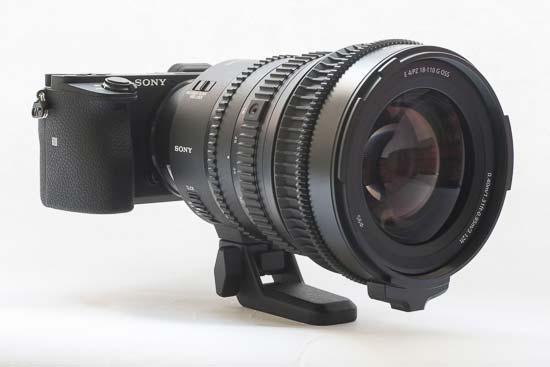 The Sony E PZ 18-110mm f/4 G OSS lens mounted on a Sony A6500 camera body
The Sony E PZ 18-110mm f/4 G OSS lens mounted on a Sony A6500 camera body
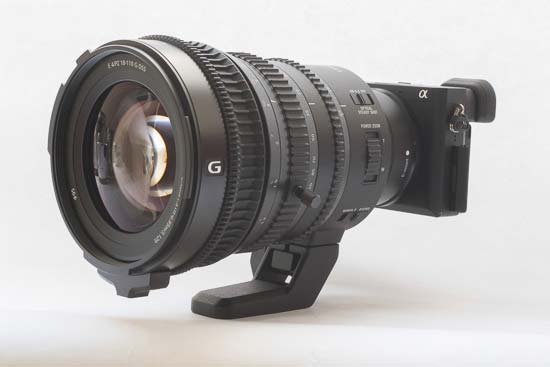 The Sony E PZ 18-110mm f/4 G OSS lens mounted on a Sony A6500 camera body
The Sony E PZ 18-110mm f/4 G OSS lens mounted on a Sony A6500 camera body
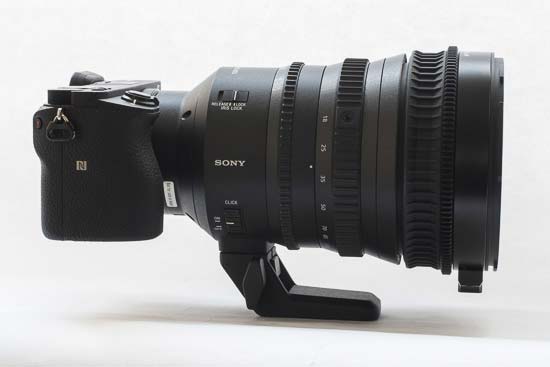 The Sony E PZ 18-110mm f/4 G OSS lens mounted on a Sony A6500 camera body
The Sony E PZ 18-110mm f/4 G OSS lens mounted on a Sony A6500 camera body
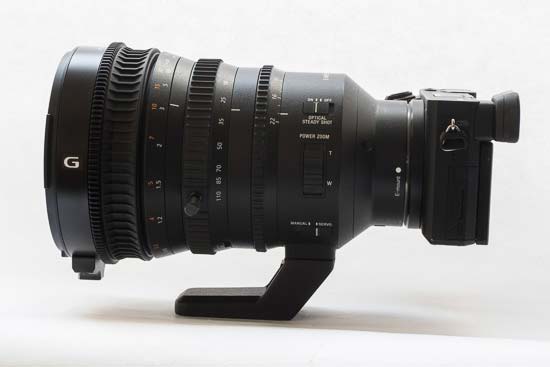 The Sony E PZ 18-110mm f/4 G OSS lens mounted on a Sony A6500 camera body
The Sony E PZ 18-110mm f/4 G OSS lens mounted on a Sony A6500 camera body
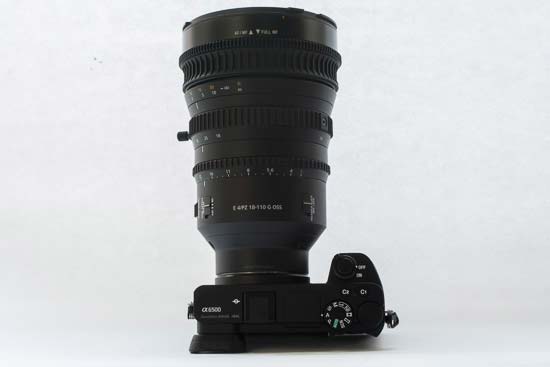 The Sony E PZ 18-110mm f/4 G OSS lens mounted on a Sony A6500 camera body
The Sony E PZ 18-110mm f/4 G OSS lens mounted on a Sony A6500 camera body
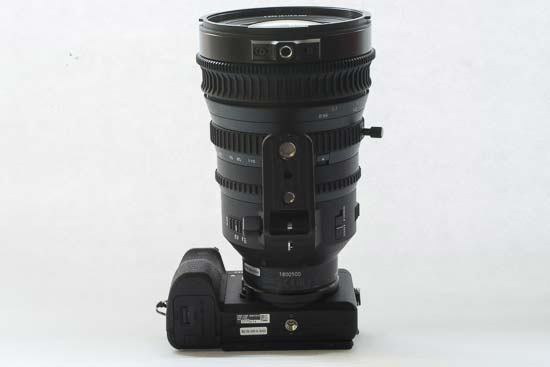 The Sony E PZ 18-110mm f/4 G OSS lens mounted on a Sony A6500 camera body
The Sony E PZ 18-110mm f/4 G OSS lens mounted on a Sony A6500 camera body
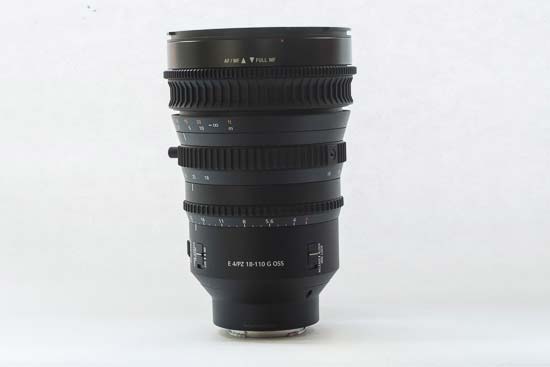 The side of the Sony E PZ 18-110mm f/4 G OSS lens
The side of the Sony E PZ 18-110mm f/4 G OSS lens
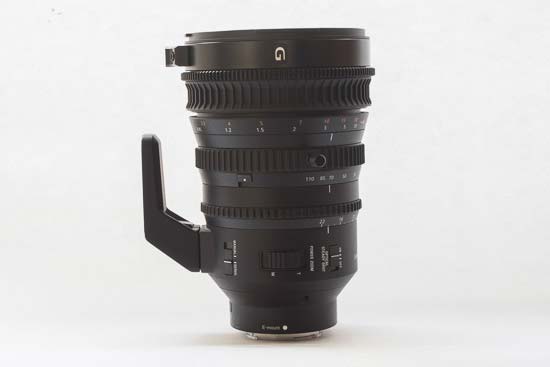 The side of the Sony E PZ 18-110mm f/4 G OSS lens
The side of the Sony E PZ 18-110mm f/4 G OSS lens
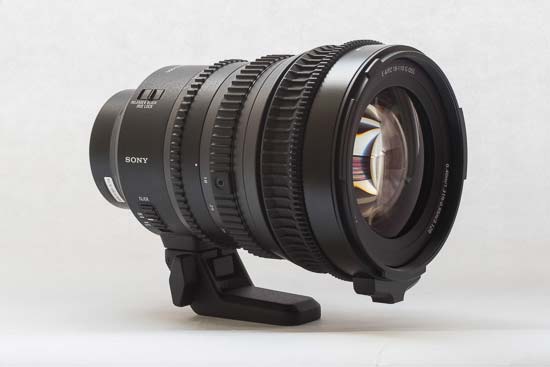 The side of the Sony E PZ 18-110mm f/4 G OSS lens
The side of the Sony E PZ 18-110mm f/4 G OSS lens
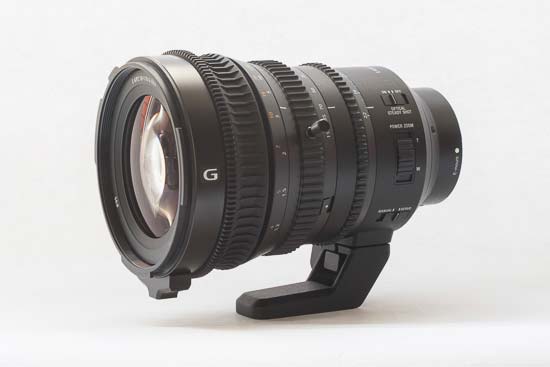 The side of the Sony E PZ 18-110mm f/4 G OSS lens
The side of the Sony E PZ 18-110mm f/4 G OSS lens
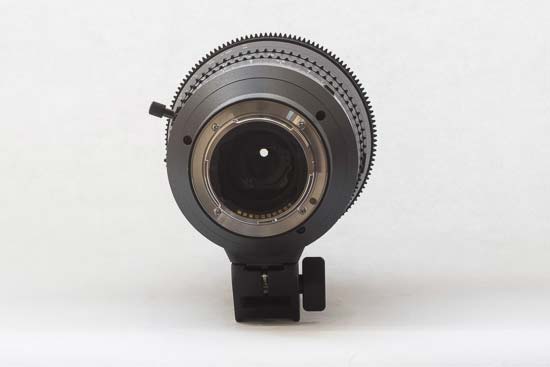 The rear of the Sony E PZ 18-110mm f/4 G OSS lenshood fitted
The rear of the Sony E PZ 18-110mm f/4 G OSS lenshood fitted
Focal Range
At the 18mm end of the zoom range, the Sony E PZ 18-110mm f/4 G OSS lens has an angle of view of 76 degrees, which gives an equivalent focal length of 27mm when used with an APS-C format camera.
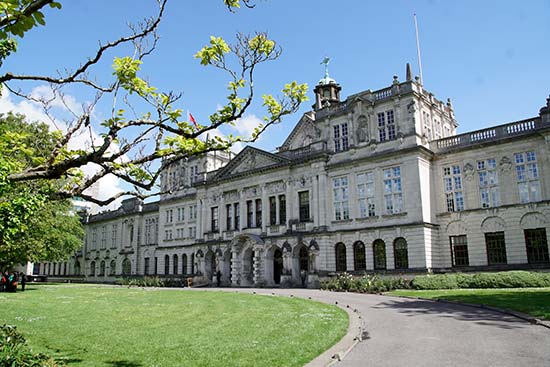 Field of view at 18mm
Field of view at 18mm
At the 110mm end, the angle of view is 14 degrees, giving an equivalent of 165mm.
 Field of view at 110mm
Field of view at 110mm
Focusing
The Sony E PZ 18-110mm f/4 G OSS lens utilises super quiet autofocusing which make it perfect for video recording.
The design also means that focus is maintained on a subject, even while zooming. While that wouldn’t matter for stills photography, for videography is is crucial to save having to focus and refocus while recording.
Focusing is quick and accurate, even in darker conditions, while taking manual control gives you the opportunity to fine tune. The 95mm filter thread doesn’t rotate when focusing, making it suitable for use with filters such as graduated neutral density filters.
Chromatic Aberrations
During testing, we struggled to find any evidence of very problematic chromatic aberration. This is typically demonstrated as purple or blue fingers along high contrast edges. You can see it some areas where there are very high contrast areas, but it is pretty well controlled and unlikely to spoil most images.
 |
 |
Light Fall-off
At the widest point of the Sony E PZ 18-110mm f/4 G OSS lens, there is some obvious darkening in the corners when shooting a white wall at the maximum aperture of f/4. It’s evident in both JPEG and raw format images. The effect is lessened when shooting at f/5.6, and is non-existent by the time you get to f/8. While it is obvious when shooting a white wall, for normal subjects, it’s less likely to be an issue. It’s a reasonably similar story through the different focal lengths, with darkening visible in the corners at the widest aperture.


Distortion
Distortion is visible when shooting at the widest angle of 18mm, especially if you are reasonably close to the subject. This can be mitigated by moving back, or zooming in to use shorter focal lengths. It’s particularly noticeable when shooting something with straight lines, but other subjects are less likely to demonstrate the problem quite so clearly.


Macro
The Sony E PZ 18-110mm f/4 G OSS Lens is not really designed as a macro lens. The minimum focusing distance at the wide angle end is 0.4m / 1.31 ft. At the tele end, the minimum focusing distance is 0.95m / 3.12 feet. The magnification is 0.122x.
 Close-up performance
Close-up performance
Bokeh
The out of focus areas produced by the Sony E PZ 18-110mm f/4 G OSS lens are smooth and attractive. A maximum aperture of f/4 is available throughout the focal range, meaning you can get shallow depth of field effects even when shooting at longer focal lengths. Since appreciation of bokeh is often reasonably subjective, we have provided some examples below to help you make up your own mind.
 |
 |
 |
 |
Sharpness
In order to show you how sharp this lens is, we are providing 100% crops on the following pages.
